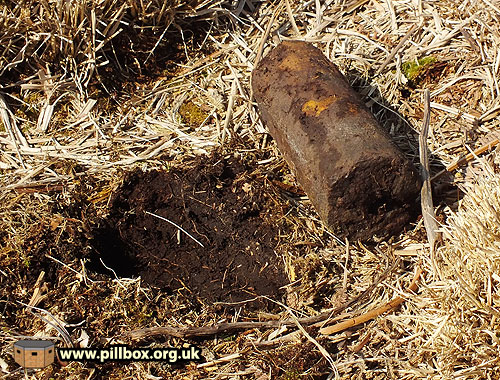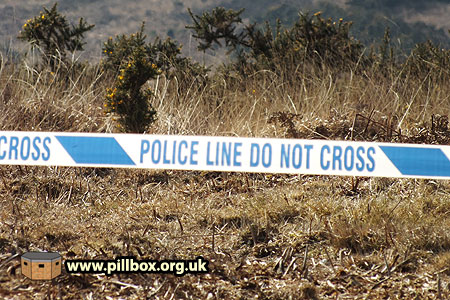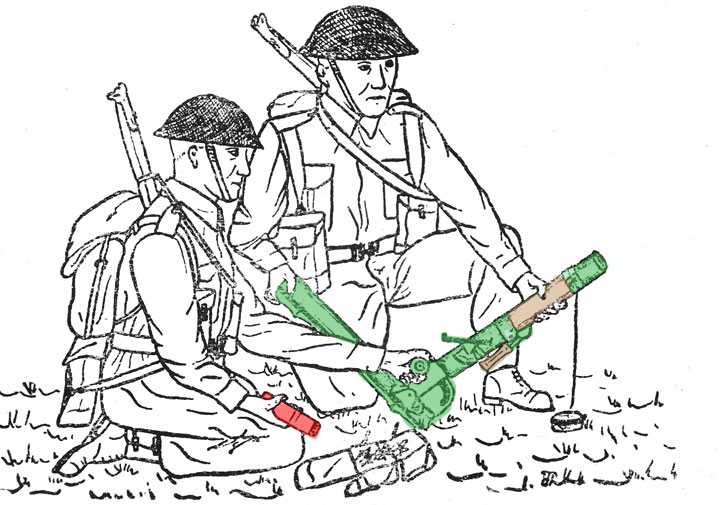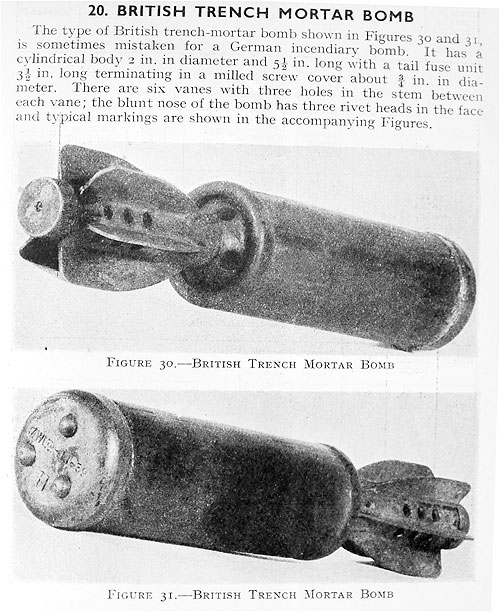Safety first!
Posted: 6 April 2013 20:26
It is often said that perhaps a million unexploded shells still lie beneath the WW1 battlefields of France and Belgium, but today I experienced an unexploded device in Sussex.
The object in question was a 2-inch mortar bomb and it was safely removed by a Bomb Disposal squad.
I was actually out looking for some slit trenches and enjoying the first bit of sunshine of spring in a former army training area.
I'm not going to identify the location for two reasons: firstly, regular readers will be aware of my policy of not revealing locations to avoid heritage vandalism or destruction of conservation habitats, but also because I don't want to put people off from visiting the countryside.

Having found some slit trenches, I was just marking them on my GPS when I felt a strange feeling under my foot.
I looked down to see that I had trodden on one end of a small rusty cylinder, causing the other end to pop up.
Nudging it with my foot, the cylinder rolled on the grass and I then suddenly realised what I might be dealing with.
I had a very strong feeling that this was the explosive section of a 2-inch mortar bomb; the tail fin unit had probably broken off on impact.
In these cases, you simply can't take any chances - so I rang 999 and informed the authorities of my latest discovery.
A couple of minutes later a police car rolled up and I lead two officers to the site.

A 100m cordon was established and dozens of walkers had their afternoon disrupted by unexpected detours around the area.
After a few radio conversations and a description of the device, it was decided that an Explosive Ordnance Disposal (EOD) team should attend the scene.
The time waiting for the EOD team to arrive was wiled away chatting with the police officers and showing the above photo on my camera to interested passers-by who were wondering what all the fuss was about.
Most people were shocked that a WW2 bomb might still be lying in the ground, but it's more common than you might think. I've been reliably informed that an unexploded 50kg German bomb was removed by an EOD team a few weeks ago in East Sussex, not to mention the British bomb dredged up by fishing nets just last week.
Today's incident was therefore a mediocre task for an EOD team by comparison. The EOD officer examined my find; waiting outside the cordon I awaited the verdict, hoping that I hadn't just dragged his team 60 miles on my hunch that this thing was a bomb. It would be quite embarrassing if it only turned out to be a baked bean tin.
Fortunately, the police had already been through a rigorous process with me to ascertain why I felt the object might be a bomb. My reasoning was the size and shape of the object, my having been in the TA some years ago and seen similar objects on training areas and told not to touch them. The police also knew that EOD teams had been called to this area on previous occasions.
The EOD officer walked back, carrying the object with him - it was obviously not deemed dangerous! It was, indeed, a 2-inch mortar bomb, but possibly a smoke round. However, it could easily have been a high explosive round and so it certainly warranted treating it with respect.
The 2-inch mortar
The 2-inch mortar nominally had a crew of two men, although it could be served by a single operator. The graphic below comes from the training manual; I've coloured in the weapon itself and the bomb held by the assistant.


The illustration at right comes from the 1941 edition of the Objects dropped from the air pamphlet; the mortar bomb was included in this publication for purposes of elimination.
My documentary research highlights the danger of even a small explosive device such as the 2-inch mortar bomb.
I know of one unfortunate Canadian soldier who was actually struck by a 2-inch mortar bomb on a live-firing exercise. Being relatively light, the bomb had been blown off course by a strong cross-wind and into the soldier's position; sadly, he died in the back of an ambulance en route to hospital.
In 1941, a group of young boys found an unexploded 2-inch mortar bomb following an army exercise on the South Downs and began playing with it, with tragic results.
Following this tragedy, training areas in Sussex were ordered to be swept following live firing exercises.
Having located the grave of one of the victims a few years ago and comprehended the family's grief by reading the inscription on the headstone, I could not allow a similar device to remain a potential threat.
Postwar clearance
After the war, the Battlefield Clearance Unit (BACU) was tasked with the problem of clearing up minefields and training areas, but the sheer volume of rounds expended meant that a 100% certainty that areas were cleared was impossible to guarantee. So many missiles will have buried themselves and are only now coming to the surface through ploughing, burrowing animal activity or undergrowth clearance. It appears that the area in which I found this bomb had recently been mown.
Another file includes an extract from Hansard (which records Parliamentary proceedings) following a tragedy in 1950 where a person was killed by an unexploded missile; the advice given was "The War Office are very much concerned at what happened on that occasion...However...where missiles and other things are found...they should be left severely alone."
I completely concur with this advice, hence my raising the alarm on a slight suspicion of this being a potentially dangerous device.
Although it's not impossible that you may encounter something like this, I would say the chances aren't very high; this is the first live ordnance I've found in seven years of focussed research into military activity in East Sussex on top of 20+ years of roaming former training areas. My advice is for you to get out and enjoy the landscape and not worry about such things. If you do encounter something like this, then just dial 999.
The one thing that came across to me from the 999 operator, every police officer (I met four today) and the EOD officer was that calling them out was absolutely the right thing to do; it's never a waste of time to ensure safety in these matters.
It's always better to be safe than sorry.
UPDATE: I spoke too soon - one week later I found five similar bombs 20 miles away!
- Pete

Email:
Blog Latest

Bishopstone reveals its pillbox secrets
18 October 2021

Pillbox or Observation Post?
10 June 2020

Uncovering the hidden secrets of a pillbox
8 June 2019

Review of 2018
31 December 2018

Wartime Christmas in East Sussex (2)
24 December 2018
Jargon-buster
Slit trench
Small, narrow trench designed to provide protection against shrapnel and other battlefield hazards. Technically distinct from a weapon pit (which was intended soley as a defensive position) slit trenches were also used as defence works.
This site is copyright © Peter Hibbs 2006 - 2024. All rights reserved.
Hibbs, Peter Safety first! (2024) Available at: http://pillbox.org.uk/blog/216722/ Accessed: 27 July 2024
The information on this website is intended solely to describe the ongoing research activity of The Defence of East Sussex Project; it is not comprehensive or properly presented. It is therefore NOT suitable as a basis for producing derivative works or surveys!